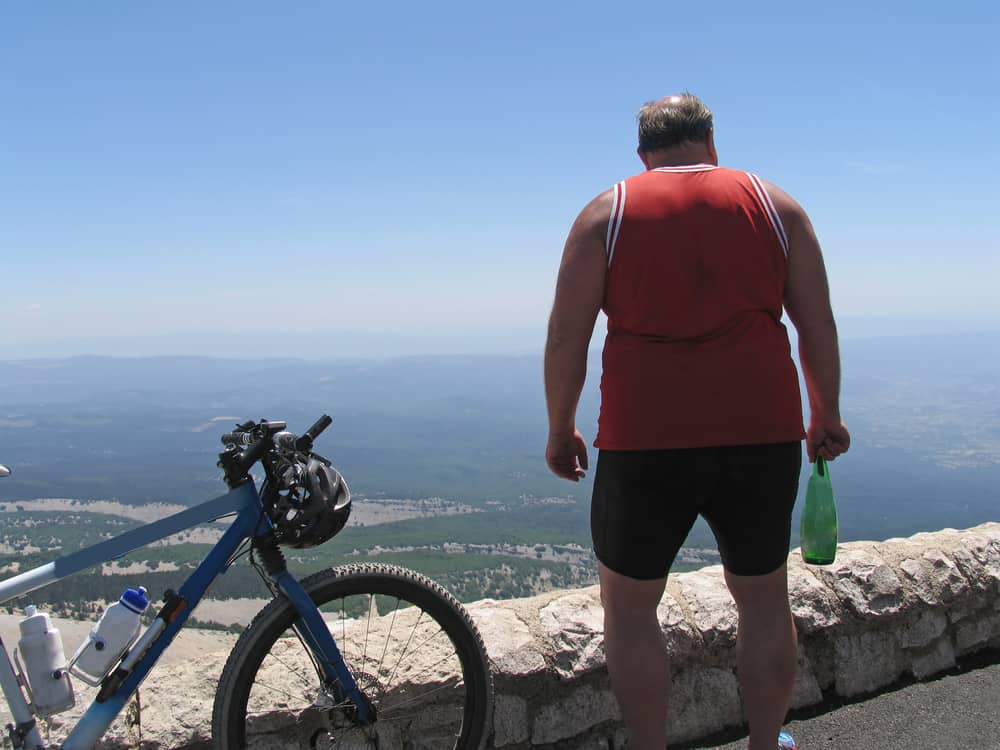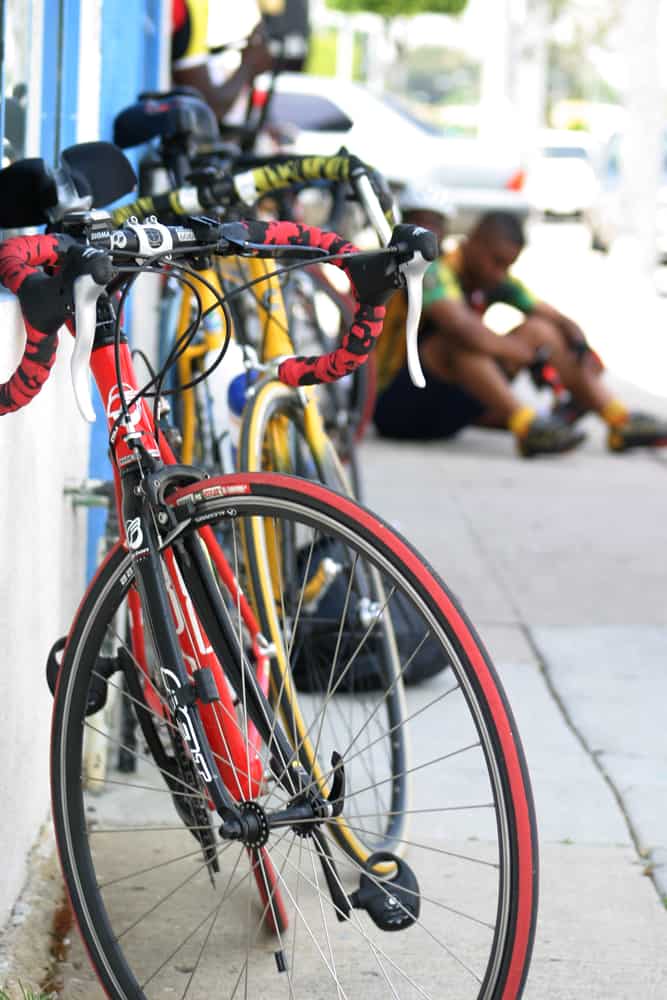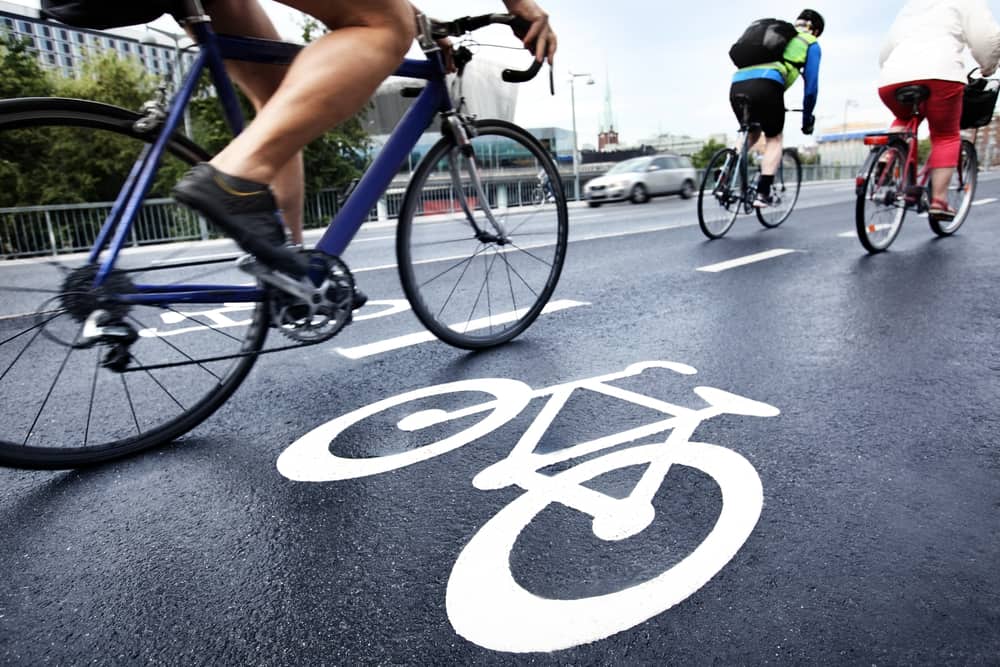If you’re overweight and keen on cycling the right way, you’ve reached the correct spot. We’ll tell you all that overweight cyclists need to know for a comfortable 2-wheeled experience.
Whether you want to ride for fun, for transportation, or to lose weight, there are certain things you need to keep in mind.
From choosing the right bike to buying suitable cycling clothes, we leave no stone unturned to help you ride to your satisfaction.
Is Biking Suitable for Overweight People?
Yes! Biking is suitable for just about anyone, including overweight people.
If you’re overweight, you’ll have to start cycling in moderation before your body adapts to the new workout.
Why is Biking Good for Overweight People?
The obvious answer is to stay fit and lose weight.
Biking helps raise the metabolic rate, build muscle, and burn body fat. Since you can change the duration and intensity of riding a bike, you can suit your needs according to your body.

Benefits of Regular Cycling for Obese/Overweight Riders
Regular cycling offers benefits of stronger heart muscles, a lower resting pulse, and reduced blood fat levels.
Besides obesity/weight control, regular cycling is good for strength and stamina. You’ll notice your stamina, strength, and aerobic fitness improve with time.
The health risks that obese people face, like heart diseases, diabetes, certain cancers, and high blood pressure, can be reduced with exercise, such as regular cycling.
Intensity Per Week
Remember not to over-exert yourself when you start cycling. You could start off riding a few days a week, perhaps every alternate day.
Gradually, the duration of your rides could get longer. Once your body feels comfortable cycling for longer, you could make this a daily routine, as per your convenience.
You must always listen to your body for the frequency, speed, and distance you ride.
Time to Recharge
It would help if you gave your body time to recharge; this counts as downtime to build muscle. Proper sleep and good nutrition help in the recharge process.
Even if you’re riding for weight loss, you mustn’t skip meals, especially right after a ride. Load up on carbohydrates and proteins to build strength, help your body heal, and maintain your health.
Intermittent recovery rides do a load of good for your body. Squeezing these in-between high-intensity rides helps your body cope better.
Track Your Progress
There are so many apps these days that help track your riding progress, including mileage and intensity.
With a fitness tracking app, you’re bound to stay motivated to reach specific goals.

How to Start Cycling When Overweight
We can imagine the confusion when you start cycling and don’t know how to proceed. Don’t worry! Here are a few things we recommend for an easy start:
Set Realistic Goals and Plans
The first few rides for an overweight cyclist can be demanding on the body.
Rather than starting right away with long rides or tours, start gradually. Plan out short rides for a good start.
Set realistic goals that you can achieve and that you enjoy achieving too.
If you’d like to cycle to work every day or ride 40 miles over the weekends, go for it! Just don’t do it the first few times when you start cycling.
Go for Flat Terrain
Riding over hilly terrains might be tempting when you just get started. We suggest avoiding this since even a few degrees of uphill climbing takes up a lot of energy.
Instead, start easy, with flat, short routes to ride on. Once you’re sufficiently used to it, go for elevations slowly.
If you’re starting with little or no prior activity, consider biking for 15-30 minutes a day, a few days of the week. Rather than distance, it’s the duration of cycling you must focus on.
You can slowly increase the frequency and duration of riding, eventually covering longer distances.
Must-Have Accessories
As an overweight beginner, it would be beneficial to have these accessories handy for your first rides:
- Helmet: A helmet that properly fits your head will keep you safe from accidental falls. It provides reassurance until you’re a confident rider (you could use it even after you’re experienced).
- Pump: There’s no saying how well your tires will hold up your weight when you start off. It would be wise to have at least a mini pump, if not a full-size pump, on you to pressure up your bike’s tires faster, if needed.
- Lights: An essential accessory to have on your bike are lights – front and rear. If you cycle after dark or go over unlit roads, lights help illuminate the road and make you visible to others.
Make A Routine
Setting a routine for yourself makes every ride easier. Prepare a checklist of what you need to get done before you set out for a ride:
- Put on your cycling clothes and have your helmet on.
- Apply sunscreen lotion on the exposed parts if it’s blazing outside.
- Fill up a bottle with water or energy drinks to keep you hydrated on your ride.
- Check the tires and ensure optimal pressure.
- Check the contents of your saddlebag or backpack and ensure you have some spare tubes, a pump, tools, and a patch kit.
- Make sure that your bike has a smooth operation before you set out.
- Set up a heart rate monitor and bike computer if you’re keen on losing weight cycling.

Find A Bike That Works for You
Most bikes that suit lean cyclists don’t work for an overweight cyclist.
Don’t fall for the sleek and enticing looks of bikes. Instead, analyze your requirements and match them with the bike’s specifications.
We suggest you start by going over some of these questions:
What Kind of Riding Will You Be Doing?
There is a whole range of bikes that serve different purposes. Depending on what you intend to use your bike for, it would be best to go for one that serves the purpose.
- Running your daily errands, including carrying groceries
- Commuting for work
- Riding for exercise and losing weight
- Racing in events or competitive riding
- Adventure rides for camping, touring, or trekking
- Riding for fitness
What Surfaces Will You Be Riding?
You can’t use just any bike for any surface. Bikes are made for specific purposes and surfaces.
Before you go to a bike shop to purchase a brand-new bike, you must decide which one of these surfaces you’ll be riding on more often:
- Only flat surfaces like roads
- A mix of road, trail, and gravel
- Over any and every surface (to satisfy your adventurous side)
Are You Concerned About Bike Material?
The three materials used to make most modern bikes are aluminum, steel, and carbon.
Fun Fact: Some awfully expensive bikes are made of titanium too!
While aluminum is common in most budget and entry-level bikes, we suggest heavier riders look for ones with steel. It’s pretty durable and has higher weight limits (a plus if you’ll be carrying cargo.)
You could do your bit of research about this before visiting the bike shop. Quite often, the employees there wouldn’t be experienced in dealing with an overweight cyclist.
Lucky for you, most bike manufacturers specify the weight limits with each of their models online.
What is Important When Buying A Bike and You Are Overweight?
We know how difficult it gets for fat people to find the right bike. Here are some essential pointers to make it easier:
Wheel Strength
You’ll need stronger wheels that can carry your extra weight without breaking.
Wheels have three components: hub, rim, and spokes. You must ensure all of these are sturdy enough to support your weight. Usually, smaller wheels are stronger than larger ones. They also reduce the bike’s overall weight.
Look for a sturdy rear wheel with at least 24 spokes. The more the spokes, the more weight your bike can support.
A strong wheel with quality rims and strong spokes makes a good bike for overweight cyclists.
Tire Width
Often, wider tires provide more comfort and cushioning. Even better, you get the flexibility to ride at lower pressures.
We strongly suggest heavier riders keep a good cycle pump handy at home. You can avoid flats by filling your tires with the recommended PSI before every ride.
How About Other Components?
You can always customize your bike after you’ve purchased it.
Modifying the handlebars, saddle, pedals, etc., can be done by either a bike mechanic or as a DIY project (if you’re up for it). Get whatever modifications you desire, as it makes a big difference in riding with comfort.
With e-bike conversion kits, you could even convert most bikes into electric bikes. An electric bike is a good choice if you’ve just started cycling and would like to go on longer rides more frequently.
Wear Clothes That Make You Feel Good and Comfortable
Dressing for your body type is important whether you’re on a bicycle or off it.
You don’t have to dress up the way a thin person from the cycling community would – lycra, clip-on shoes, and tiny bike hats.
You can ride your bike wearing anything that you’re comfortable with. You can ride longer distances if you feel good, confident, and comfortable.
Go with some shorts and loose shirts for the summer, wool layers in the winter, and a rain cape if you love riding in the rain.
Of course, we aren’t saying bike clothes won’t work for overweight cyclists; you could search for one that’s your size. There is the sports performance factor that you could benefit from bike clothes.
Brands That Make Bike Clothes for Overweight Cyclists
The bike world’s attitude towards overweight cyclists may be changing at a snail’s pace, but there sure are athletic brands that are more welcoming.
Several brands are designing cycling clothes and accessories in expanded size ranges. Brands like Pearl Izumi and De Marchi have sizes up to 2XL.
Fat Lad at the Back specializes in cycling clothes for fat cyclists. Covering sizes from 36″-54″ in men’s jerseys, tops, and jackets to 34″-53″ (UK) size in women’s, there’s a whole range of cycling clothes to choose from.
Some brands also make a wide range of sizes for women’s cycling apparel. From Fat Lass at the Back offering sizes up to 6XL to Aero Tech Design going up to 5XL, there’s also Team Estrogen with 2XL.
If you’d like custom cycling gear for added comfort, Artletic Apparel and ellemenTRI will help you out.
Types of Cycling Clothes
For someone who gets a bike for weight loss, training, or leisure, different clothes will make riding more comfortable. Here are a few that you need to consider:
- Shorts: Cycling shorts made of stretchy Lycra/Nylon are padded for cushioning. Among waist shorts and bib shorts, the latter is more comfortable.
- Jerseys: Cycling jerseys are shaped like a t-shirt and have a high neck for sun protection, a front zip, and pockets at the back. There are sleeveless jerseys and the more common short or long-sleeved ones.
- Socks: The typical cycling socks are made of thin, sweat-wicking fabrics. These have padding with a thicker layer on the sole.
Time to Get Cycling Already!
There you have it! Don’t hold back on cycling if you consider yourself obese or overweight.
We hope the information we have provided in this guide is helpful to get you cycling to your heart’s content.
Don’t feel disappointed when you start. With the right bike, clothes, and company, you’ll enjoy every riding experience.